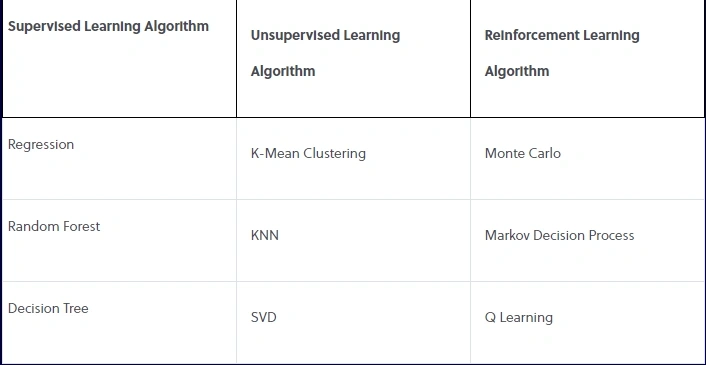How to Choose the Right Machine Learning Algorithm
Selecting the correct machine learning algorithm can be difficult, but doing so is critical in order to answer a given question with high speed and accuracy. In this blog, we will introduce three types of machine learning algorithms and explain how to select the right one when tackling business problems. Then, we share a few real-world use cases for the different algorithm types.
Before understanding how to choose the best machine learning algorithms let us briefly look into the types of machine learning algorithms. The machine learning algorithm can be broadly classified into three groups.

- Supervised learning model: Trained with the dataset which consists of labels for both Input and output.
- Unsupervised learning model: Trained with the dataset that has input features but does not have labels for the output.
- Reinforcement learning model: Trains itself based on a set of actions and makes the decision.
Now, let’s learn when to use these algorithms rather than how to use these algorithms. Choosing the correct algorithm is dependent on multiple variables. A good understanding of data science plays a very significant role in categorizing the problem statement.
The factors we need to consider while categorizing and solving the problem are:
- Knowledge of Data: The data’s structure and complexity help dictate the right algorithm
- Accuracy Requirements: Different questions demand different degrees of accuracy, which influences algorithm selection
- Processing Speed: Algorithm choice may depend on the time constraints in place for a given analysis
- Variables: The unique features considered while training the model for the optimal result and accuracy help determine the right algorithm.
- Parameters: Factors such as the number of iterations directly relate to the training time needed when generating output.
Our first step is to analyze the data and observe the patterns and any hidden insights by visualizing the data. The insights from data visualization will help in making an initial decision on which algorithm to choose for solving the given problem.
As an example, if the dataset has input and output labels, a supervised learning algorithm will be best for the problem. Supervised learning can be segregated further based on the type of output. For any numeric output, one should choose a regression algorithm to train the model, but for any class output, one should target a classification algorithm to train the model.
If the dataset has no output labels, choosing an unsupervised learning algorithm will be a wise decision, for example, the K-Mean clustering algorithm comes in handy in dividing the dataset into a smaller cluster or set based on similar attributes.
The characteristics and behavior of the dataset also play an important role in making the ideal algorithm selection. For example, if the data is sequential, like stock price or heart rate, then the algorithm that fits best is the Markov model and decision tree.
Another important factor in deciding the algorithm is speed and accuracy. There is a tradeoff between speed and accuracy. If accuracy is not vital, perhaps when estimating a value, we can reduce the processing time, thus increasing the execution speed. Conversely, we can achieve better accuracy by slowing the execution speed.
Another factor that plays an important role in choosing the correct algorithm is the number and types of parameters we pass while training the model. These parameters may include iteration cycle, splitting train and test datasets, error tolerance, and more. The training time for a given model is directly proportional to the number of parameters included. When multiple parameters are required to train the model, SVM (Support Vector Machine) algorithms work well.
Real-Life Use Cases
Linear Regression
This can be used to predict housing prices based on multiple variables including square footage, the presence of a balcony, the number of bathrooms, total rooms, kitchen area, etc.
Each of these variables plays an important role in predicting the accurate housing price. A co-relation of 1 indicates a perfect relationship and accurate housing price, anything less than 0.9 can safely be assumed as unreliable prediction.
Logistic Regression
Currently, bank customers face the constant threat of credit card and identity fraud. As a result, the financial sector is working to devise new techniques to avoid these problems. One of the steps banks have taken to reduce fraud is by leveraging logistic regression to build a classifier, known as the LogR classifier, which adapts to the user’s behavior based on his historic data. As a result, financial institutions can more accurately distinguish their true customers from any impersonator.
Support Vector Machine (SVM)
This helps in handwriting detection using a support vector machine classifier. It has achieved accuracy of up to 96% when converting handwritten notes into text-based data.
Random Forest
Random Forest algorithms can be used to predict equipment failure and schedule just-in-time preventive maintenance. The failure of the equipment, such as utility poles or transformers, can be caused by cracks, corrosion pitting, spalls on rolling surfaces, and more. These failures can be catastrophic and financially devastate a given organization.
Taking advance of Random Forest machine learning algorithms and AI to monitor these assets may help in detecting failures at their earliest stages, reducing or preventing damage to the asset and the organization’s bottom line altogether.
K-Mean
Uber, Lyft and other rideshare apps utilize K-Mean machine learning algorithms for optimal placing and clustering of their vehicles based on the peak demand. As a result, customers enjoy reduced wait times and helps the rideshare companies dictate surge pricing when supply is low and demand is high.
In Conclusion
As we have discussed, machine learning algorithms generally fall into one of three categories – supervised learning, unsupervised learning, and reinforcement learning. When addressing different types of business challenges, analysts should carefully consider the characteristics of the data, speed and accuracy requirements, variables, and parameters in order to yield the desired insights.
By using the proper algorithms, organizations can expect to benefit from stronger data insights that reflect the unique conditions that guide each business process. As their algorithms continually learn and improve, so will the data-driven decisions that result.
Let's get your data streamlined today!
Other Blogs
In the race to digital transformation, where should utilities start?
Almost every business leader in the utility space and beyond has heard the buzz about “digital transformation.” And for good reason! The right digital
The ESG Movement for Utilities
“ESG-oriented investing has experienced a meteoric rise. Global sustainable investment now tops $30 trillion—up 68 percent since 2014 and tenfold sinc
A New Imperative for Utilities to Manage their Unbilled Revenue
“While regulators generally allow utilities to recover prudently incurred costs from ratepayers, utilities are always cognizant of the effect rising c
